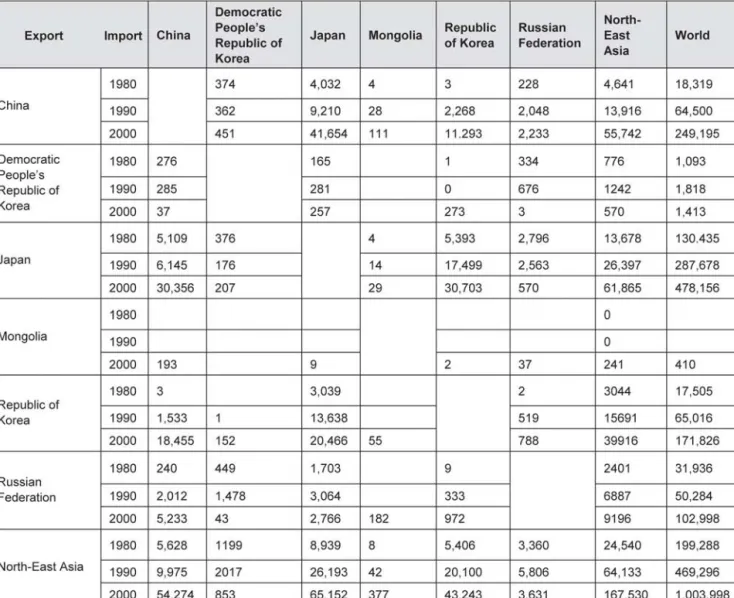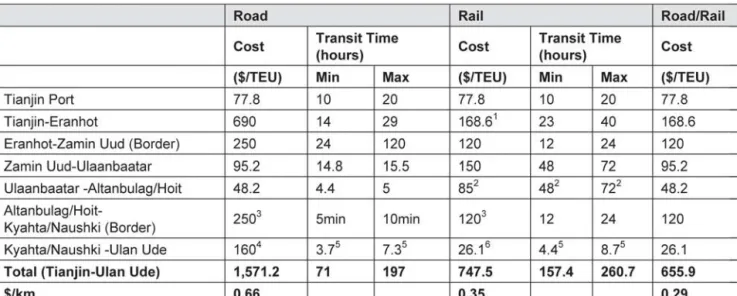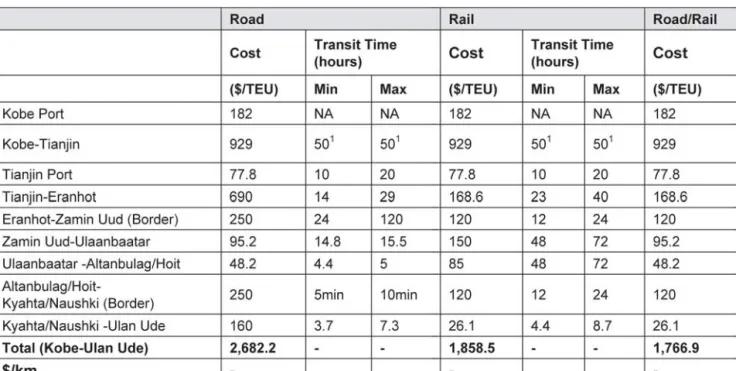LIST OF BOXES
ONE: INTRODUCTION
Following this introductory chapter, Chapter 2 reviews the existing international transport and logistics facilities in Northeast Asia. Finally, Chapter 6 proposes strategies and actions for developing the integrated international transport and logistics system for Northeast Asia.
TWO: OVERVIEW OF TRANSPORT AND LOGISTICS IN NORTH-EAST ASIA
ECONOMIC AND TRANSPORTATION TRENDS IN NORTH-EAST ASIA
The main reason for this expectation is the high level of economic complementarity that exists between countries in Northeast Asia. There were a series of discussions and proposals on regional development and infrastructure in Northeast Asia.
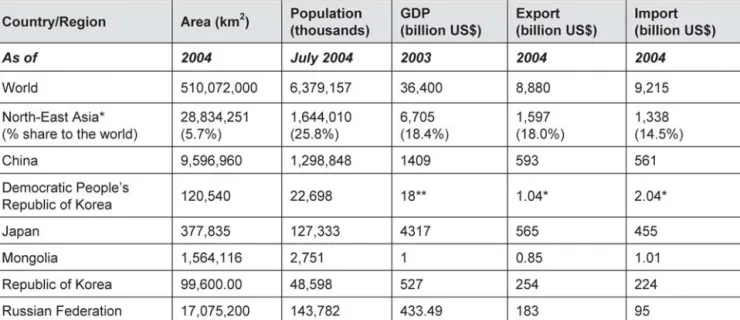
TRANSPORT AND LOGISTICS IN NORTH-EAST ASIA
As well as passenger railways, China experiences the largest amount of freight tonne-kilometres traveled by rail among Northeast Asian countries. Container movements at major Northeast Asian ports have shown spectacular growth in most cases, with the exception of ports in Japan.

TRANSPORT AND LOGISTICS INFRASTRUCTURE IN NORTH-EAST ASIA .1 Existing conditions of transport infrastruture in North-East Asian countries
In 2003, seven Chinese ports were included in the top 30 container ports – Shanghai, Shenzhen, Qingdao, Tianjin, Guangzhou, Ningbo and Xiamen.2 Dalian Port, located at the southern tip of the Liaodong Peninsula, serves as a gateway to China's northeastern provinces. In addition, the Ministry of Construction and Transport has established an integrated logistics network - KTLOGIS - supported by manufacturing companies, transport companies and warehousing companies.
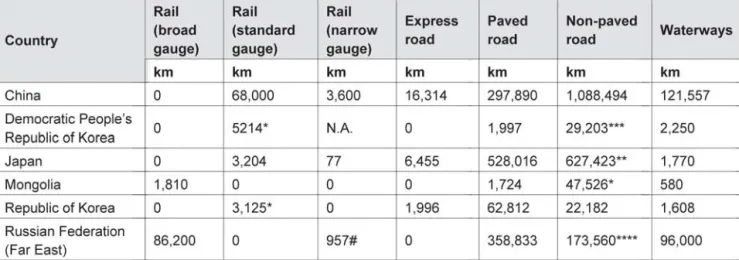
THREE: FORMULATION OF AN INTEGRATED INTERNATIONAL TRANSPORT AND LOGISTICS SYSTEM FOR
NORTH-EAST ASIA
MAIN PRINCIPLES OF FORMULATIONS OF THE INTEGRATED TRANSPORT AND LOGISTICS NETWORK
The system is expected to eventually meet the demands of international traffic within the Northeast Asia sub-region, as well as between Northeast Asia and other parts of the world. f) The system must be designed primarily for the efficient transport of ISO and non-ISO containers, which are the main containers used in international trade (Table 3-1). To ensure its reliability and efficiency, the transport-logistics system must integrate infrastructure and logistics components in the following composition.
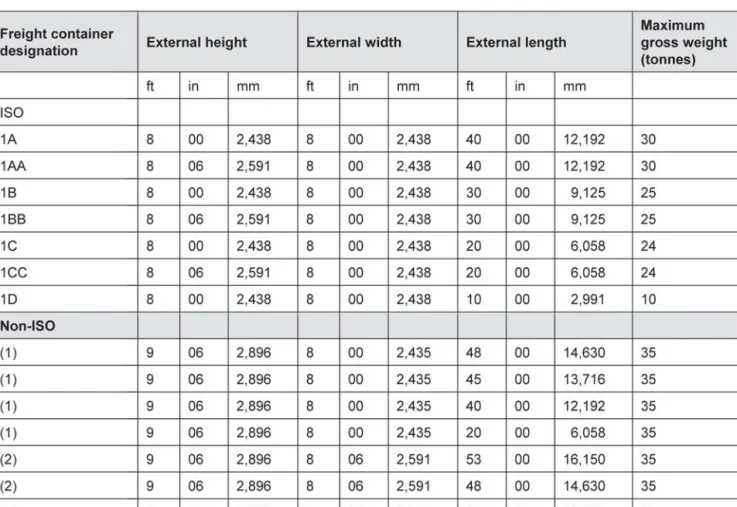
PROPOSED INTEGRATED INTERNATIONAL TRANSPORT NETWORK IN NORTH-EAST ASIA
The proposed network was reviewed by national experts from participating countries, i.e. China, the Democratic People's Republic of Korea, Japan, Mongolia, the Republic of Korea and the Russian Federation. The network was also discussed together with the strategy and actions to develop the network during the sub-regional policy level expert group meeting (6-10 September 2004, Ulaanbaatar, Mongolia) and subsequently at a series of national workshops in China (10-11 August) 2005, Beijing), Mongolia (11-12 April 2005, Ulaanbaatar), the Republic of Korea (9-10 June 2005, Busan) and the Russian Federation (18-23 July 2005, Moscow and Vladivostok), which were organized as part of the project activities.
SELECTED INTERNATIONAL TRANSPORT CORRIDORS FOR ANALYSIS
The methodology is based on the premise that the unit cost of transport can vary between modes, with the steepness of the cost/time curves reflecting the actual cost, price or time. The height of the step is proportional to the level of the charge or time delay.
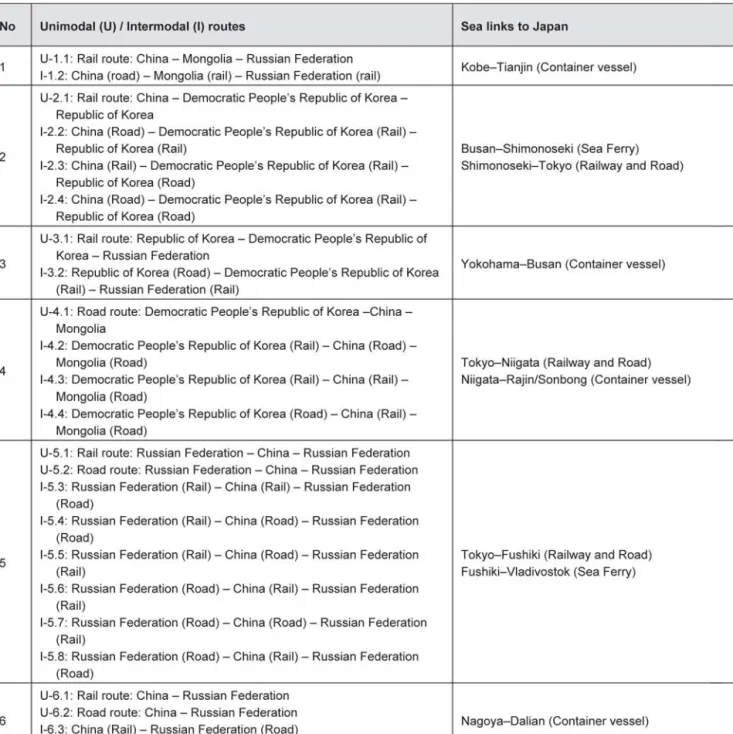
FOUR: EVALUATION OF PERFORMANCE AND IDENTIFICATION OF BOTTLENECKS IN SELECTED CORRIDORS
CORRIDOR 1
Based on tonnage, railways accounted for 86.0 percent of total freight traffic volume in 2002, while roads accounted for only 14.0 percent (Table 4-5). Based on a survey completed by national experts in each country, the cost and time to transport goods from Tianjin port to Ulan Ude are reflected in Table 4-84.

CORRIDOR 2
A study on measures for direct land transportation within the Republic of Korea and the Democratic People's Republic of Korea and the reunification of Korea. Currently, this route is not in operation due to the lack of connections between the Republic of Korea and the Democratic People's Republic of Korea. Railroads in the Democratic People's Republic of Korea section along Corridor 2 also have similar restrictions.
Distance and feature data were collected from national experts in each country (except the Democratic People's Republic of Korea). The rating is based on the maximum speed (40 km/h) and minimum speed (20 km/h) in the Democratic People's Republic of Korea.
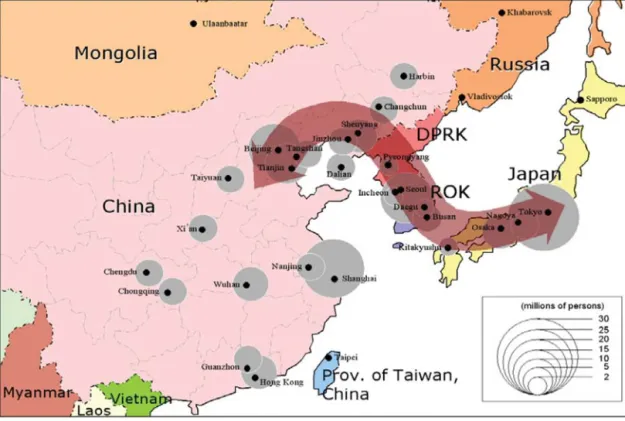
CORRIDOR 3
On the Republic of Korea side, a well-paved regular road exists from Busan to Gangnung along the eastern coastline of the Korean Peninsula. The total length of the Democratic People's Republic of Korea road section of Corridor 3 from Kosong to Rajin/Sonbong is approximately 650 km. Estimates based on maximum speed (40 km/h) and minimum speed (20 km/h) in Democratic People's Republic of Korea.
Scores for the Democratic People's Republic of Korea section are based on the values of the Republic of Korea. Intermodal route: Republic of Korea (road) - Democratic People's Republic of Korea (rail) - Russian Federation (rail).
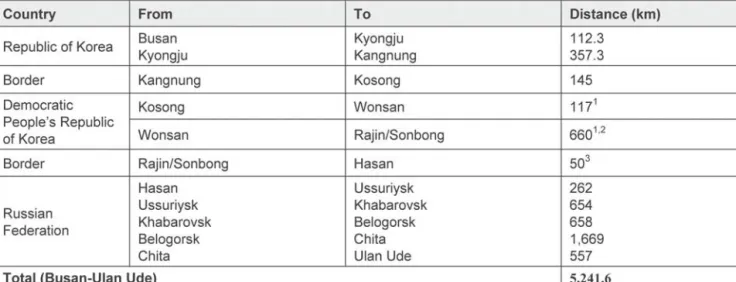
CORRIDOR 4
All rail routes in China and the Democratic People's Republic of Korea of Corridor 4 consist of non-electrified, standard gauge, single-track rail lines. Data from UNDP "Democratic People's Republic of Korea: Rajin-Wonjong Road Project, Prefeasibility Study Report (2001)". The Democratic People's Republic of Korea plans to build a highway for the stretch, and further progress of the plan requires funding.
Data from UNDP, Democratic People's Republic of Korea: Rajin-Wonjong Road Project, Prefeasibility Study Report, 2001. Intermodal routes that can currently be considered in terms of Corridor 4 are limited to a combination of road and rail only in China and the Democratic People's Republic of Korea. Republic of Korea.
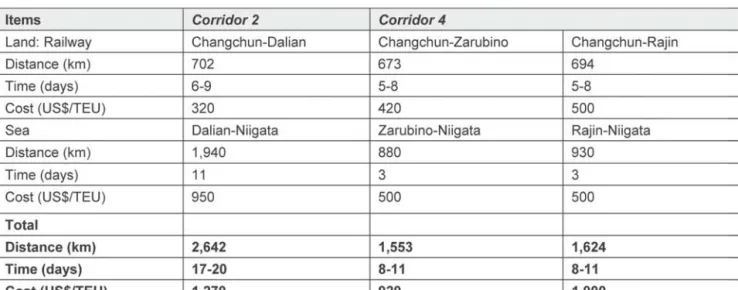
CORRIDOR 5
Double gauge tracks are installed in the border area between Grodekovo in the Russian Federation and Suifenhe in China. The total length of the railway network along Corridor 5 is 2,968 km from Nakhodka and Ulan Ude, and the distance from Vladivostok to Ulan Ude is 2,809 km (Table 4-27). By road, the distance between Nakhodka and Ulan Ude is 3,218 km, and the distance between Vladivostok and Ulan Ude is 3,049 km, about 240 km longer than the distance by rail (Table 4-28).
Considering the extended length of this corridor, using rail transportation for the entire route has the lowest transportation costs of USD 1,034 from Nakhodka and USD 960 from Vladvostok. In the Russian Federation, the rail price between Nakhodka and Godekovo is approximately USD 154 per TEU and USD 353 per TEU between Zabaikalsk and Ulan-Ude.
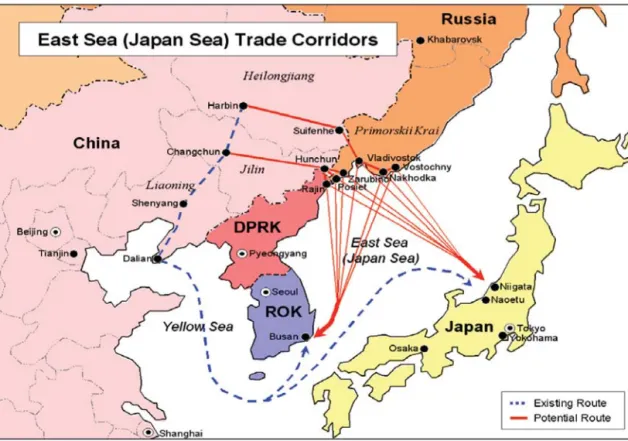
CORRIDOR 6
Double tracks are available from Dalian to Suihua and single tracks from Suihua to Heihe in China. It takes about 11.5 hours on average to travel from Dalian to Harbin, a distance of 914 km. The cost and time to transport goods from Dalian port to Belogorsk are described in Table 4-33.
1 1This travel time is significantly lower than the 26 to 51 hours for the stretch from Dalian to Heihe in Table 4-34, based on data provided by the national expert in China. Figures 4-35 and 4-36 show time-distance relationships for road and rail transport in corridor 6, from Dalian to Belogorsk.

FIVE: INTERNATIONAL LEGAL FRAMEWORK FOR TRANSPORT IN NORTH-EAST ASIA
INTERNATIONAL CONVENTIONS
The International Convention on the Harmonization of Frontier Control of Goods (1982) has so far been accepted only by the Russian Federation, and no country in Northeast Asia has acceded to the Customs Convention on the Temporary Importation of Commercial Road Vehicles (1956). The Republic of Korea also acceded to the Convention on Road Traffic (1949), while it is still a signatory to the new version of the convention (1968). Customs Convention on the International Carriage of Goods under Cover of TIR Carnets (TIR Convention), 1959.
Although the Republic of Korea is a signatory to the Road Traffic Convention (1968) and the Traffic Signs Convention (1968), it has acceded to the old version of the Road Traffic Convention (1949). The Republic of Korea has also acceded to the Convention on the Law of the Sea (1982) and major IMO conventions, including the FAL Convention (1965).
BILATERAL AND MULTILATERAL TRANSPORT AGREEMENTS
Agreement between the Government of the Russian Federation and the Government of the Republic of Albania on Maritime Transport, 1996. Agreement between the Government of the Russian Federation and the Government of the Portuguese Republic on International Automobile Communication, 1994. Agreement between the Government of the Russian Federation and the Government of Ireland on International Automobile Communication, 1994.
Agreement between the Government of the Russian Federation and the Government of the Republic of Panama on Merchant Shipping, 2003. International Road Transport Agreement between the Government of the Russian Federation and the Government of the Republic of Mongolia, 1996.
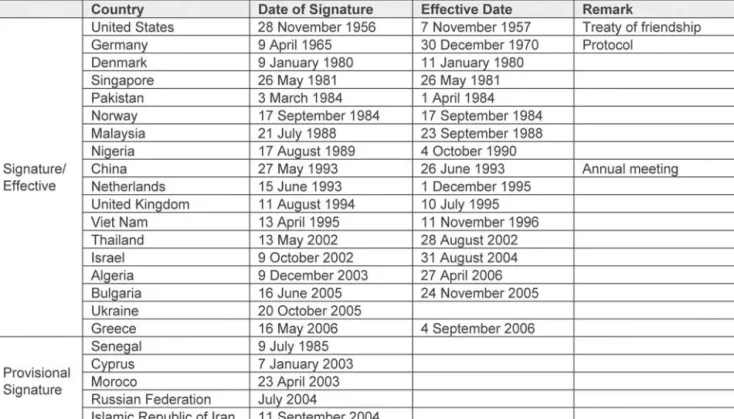
SIX: PROPOSED STRATEGY AND ACTIONS FOR THE DEVELOPMENT OF THE INTEGRATED INTERNATIONAL TRANSPORT AND
LOGISTICS SYSTEM FOR NORTH-EAST ASIA 1
ISSUES IDENTIFIED
STRATEGY AND PROPOSED ACTIONS
Simplify and harmonize transport and trade procedures and documentation particularly related to border crossings along the selected transport routes, and consider the unification of such procedures and documentation. Strengthen the position of transport and logistics intermediaries, including freight forwarders, MTOs and logistics service providers. Conduct a study on the role of ICT in transport facilitation and logistics with the development of guidelines for the ICT application in Northeast Asia.
Develop and improve the capacity and skills of policy makers on issues related to transport facilitation, including international conventions and multilateral agreements on transport facilitation. To develop the capacities and capabilities of the industry so that they can provide multimodal transport and logistics services to trade.
IMPLEMENTATION MECHANISM
Organize annual meetings among Northeast Asian countries, including meetings of National Trade and Transport Facilitation Committees (or equivalent bodies) to align/coordinate policies on transport and logistics development, to share best practices on transport and logistics planning and facilitation, and to assess progress and determine annual measures. UNESCAP will identify best practices in transport facilitation with results shared by countries. UNESCAP should provide a regional forum where trade and transport facilitation committees of Northeast Asian countries could discuss common issues with trade and transport facilitation committees of other sub-regions along certain transport routes.
UNESCAP to assist Trade and Transport Facilitation Committees to undertake the route analysis using the UNESCAP time/cost-distance model. UNESCAP to help the North East Asian countries to raise awareness and to improve capacity and skills of policy makers on issues related to transport facilitation, including the international conventions and multilateral agreements on transport facilitation.
2001), Study on Transportation Network Integration between the Republic of Korea and the Democratic People's Republic of Korea: Phase 1, Report 2001-12, Korea Transportation Institute. Ministry of Communications of the People's Republic of China (2003), Report 2002 on the Development of Maritime Transport in China. Ministry of Land, Infrastructure and Transport of Japan, Ports and Harbors of Japan 2002 Ministry of Maritime Affairs and Fisheries of the Republic of Korea, White Paper 2002-2003 Nam, Kyung-Min (2002), Major Transport Corridors in Northeast Asia : From Intraregional.
UNESCAP (1996), Trans-Asian Railway Route Requirements: Feasibility Study on Connecting Railway Networks of China, Kazakhstan, Mongolia, the Russian Federation and the Korean Peninsula. UNESCAP (2001), Asian Highway - The Road Networks Connecting China, Kazakhstan, Mongolia, the Russian Federation and the Korean Peninsula.
APPENDICES
SUMMARY OF COUNTRY REPORTS 1
CONTAINER TERMINALS AND ICDS
Note: Cargo Terminal is located on the outskirts of a major city to minimize the passage of large trucks within the city and acts as a transfer point where domestic cargo transported by trucks in major inter-large cities is sorted or classified by destination area and re-shipped. loaded onto smaller trucks entering the inside.
INFRASTRUCTURE ALONG THE SELECTED CORRIDORS
MISSING LINKS IN THE KOREAN PENINSULA
